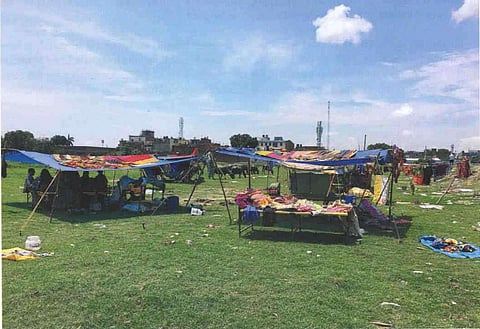Nomads and denotified tribes are the invisible people of India
Haunted by all, from common people to law enforcement, the nomads and denotified tribes lead a precarious existence devoid of the rights bestowed upon a legitimate citizen of the country. The nomadic communities like Sapera (snake-charmers), Madari (entertainers), Banjara (goods transporters), Gadulia Lohar (blacksmiths) and Aaradhi (devotional singers) have been crucial parts of India’s cultural heritage.
During British Colonial rule in India, most of the Nomadic tribes were branded ‘born criminals’. The people who once had good relationships with the rural population by providing various goods and services became criminals in their eyes.
New forms of entertainment, transportation, the medical system, and modern school education have all harmed the livelihoods of our country’s nomads. However, in the process of ‘invisibilisation’ of nomads, both historical and contemporary factors have contributed a lot today.
Invisible versus visible: A perspective
Invisibility is a relative and complex phenomenon directly associated with visibility. The word ‘invisible’ is closely linked with words like ‘hidden’, ‘dark’, ‘neglected’, ‘ignored’, and ‘marginalised’. It is a perspective of observing and analysing anything that creates the category of invisible or visible.
Here, the question of vital importance is, “Who makes something visible or invisible to whom and how?” In this context, who refers to civil society, the intellectual class and policymakers, whereas whom refers to people — or groups of people — who have been neglected or ignored on social, epistemic, and policy levels, respectively.
Because intellectuals and policymakers are drawn from civil society, these three types of institutions are inextricably linked. Today, however, who is visible and where is visible is primarily determined by the institutions mentioned above. The current piece is about Indian nomads who have become invisible as a result of historical and contemporary factors.
Nomads and denotified communities India
Traditionally, nomads transported salt and grains, entertained people, provided agricultural tools to peasants, and provided informal health care services to the settled people while living in our country with respect and dignity.
They were independent and roamed freely throughout the Indian sub-continent in search of a livelihood. However, since the introduction of colonial rule in the country, nomads’ lives and livelihoods have been impacted by a variety of factors. In the name of controlling the crimes in India, Britishers passed a legislature called the Criminal Tribes Act in 1871 that branded nearly 200 communities as ‘criminals’ by birth.
Because of the nomadic nature of their way of life, nomads had good spatial knowledge of forests and passages through them, making it difficult for the British to control them without limiting their mobility. According to the Ayyangar Committee report from 1950, the main reason for labelling some groups of people as ‘born criminals’ was economic.
Because their lives and livelihoods were based on natural resources such as water, forest, and land, policies affecting these nomads and denotified people. However, in addition to the Criminal Tribes Act (1871-1947), other legislations such as the Forest Act (1865, 1878, 1927) and Taxation on Salt (Salt Act, 1835) were also responsible for the marginalisation of nomads.
Socio-economic invisibility
People's socioeconomic status can be studied through education, income, castes and sub-castes, tribes, availability and accessibility of primary assets, amenities, and so on. New forms of entertainment have destroyed the livelihoods of acrobats and entertainers, while new medical systems have destroyed the livelihoods of traditional medicine providers and modern transportation systems have destroyed the livelihoods of traditional goods providers.
However, this segment of Indian society is on the periphery of all forms of modern development. They lack basic documents to receive state assistance, basic amenities such as drinking water, toilet and bathroom facilities, electricity, modern education, and healthcare services, and are commonly found living in makeshift and tent settlements on the outskirts of villages and towns.
Following Independence, as part of the process of mainstreaming historically disadvantaged people, some nomadic and denotified communities were included in the constitutional categories of Scheduled Castes (SCs), Scheduled Tribes (STs), and Other Backward Castes (OBCs).
To shed light on socio-economic development, the researcher has given the socio-economic profile of nomads and denotified, which have been classified as Schedule Castes by the state of Haryana. In contrast to less than one-fourth illiteracy rate for the whole state, more than half of nomads and denotified were illiterate in 2011.
Credit: Census of India, 2011
Surprisingly, in the urban sphere, which is the centre of education, the illiteracy rate is higher among these people compared to their counterparts. Looking at their participation in work, of the total population, only one-third were engaged in any kind of economic activity in urban areas, which indicated that a majority of people were out of the labour market.
Furthermore, more than a third of workers are marginal on the time scale, working fewer than 180 days per year. By analysing secondary data, we can conclude that we must pay special attention to this historically and currently invisible segment of our society in order to provide them with basic amenities and assets, particularly in urban areas.
Rahul is Doctoral Fellow at International Institute for Population Sciences in Mumbai
Views expressed are the author’s own and don’t necessarily reflect those of Down To Earth


